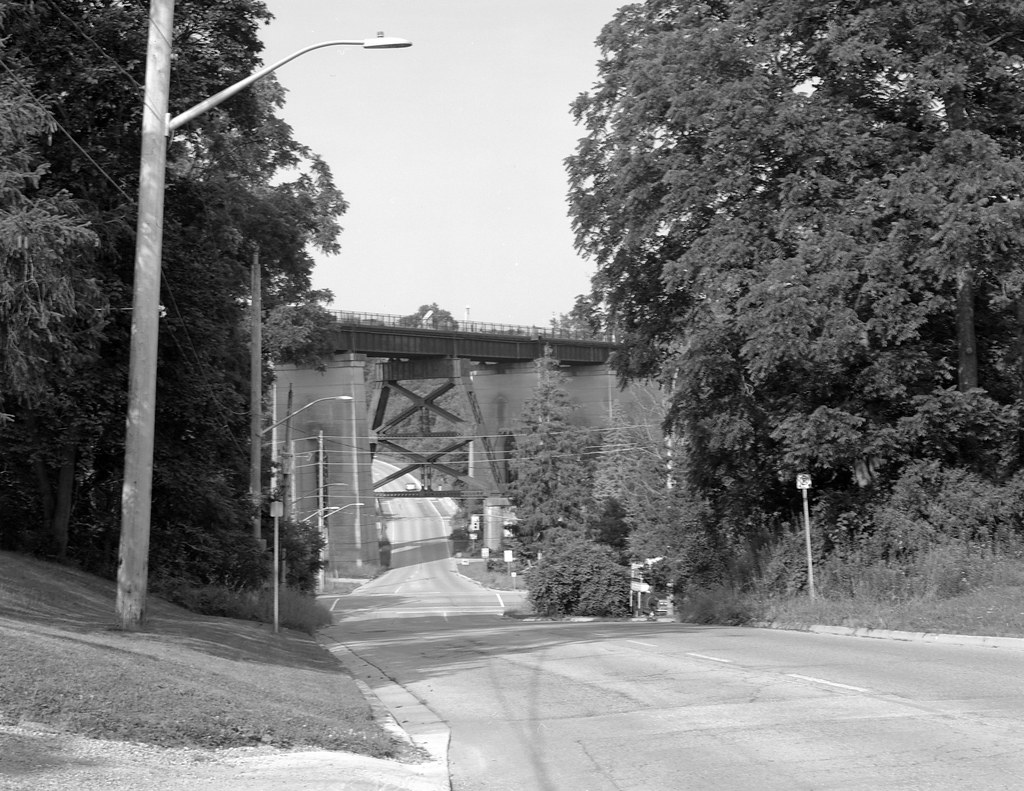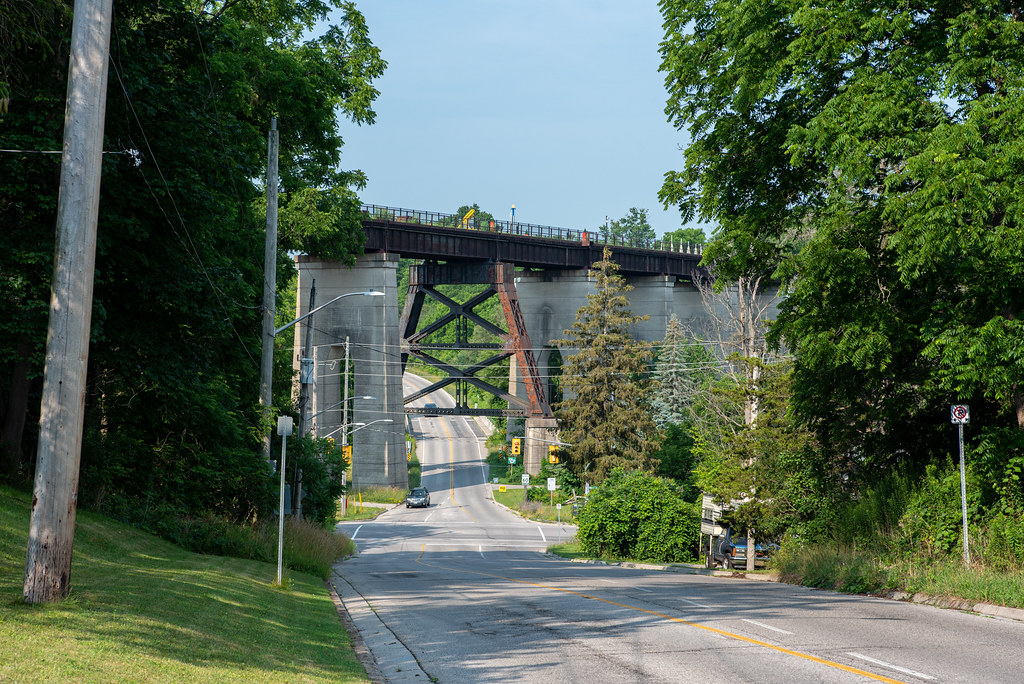If you have ever driven into and out of St. Thomas on the western side of Railroad City, there is a good chance you’ve seen the hulking rail bridge soaring high above the valley and river below. For nearly a century now, the Kettle Creek Bridge has been a significant landmark in the region, and while today it no longer serves the railroad, it continues to be an icon of the once central railway hub.

Graflex Crown Graphic – Schneider-Kreuznach Symmar-S 1:5.6/210 – Ilford HP5+ @ ASA-200 – Pyrocat-HD (1+1+100) 9:00 @ 20C
The current Kettle Creek Bridge is the third bridge to span the Kettle Creek valley. When Canadian Southern came through in 1871, the valley presented a significant obstacle. Sending a train down a steep hill and then up the other side raised a waste of power for steam locomotives of the day. The answer was to construct a bridge. The first bridge, a wooden trestle with a single track across designed by George W. Butterfield and built by Dunn, Holmes & Moore, opened to traffic in 1873 along with the rest of the Canadian Southern Line. The bridge spanned 416 metres and stood at 28 metres high, with the upper deck supported by fourteen Howe-style trusses. The bridge lasted ten years; when Michigan Central Railway leased the entire Canadian Southern Network, the old bridge proved unsuitable for the traffic Michigan Central ran across the network. A new bridge was constructed alongside the old one in 1883. The result was a long span at 425 metres and about the same height. Unlike the first bridge, the second bridge was of all-metal construction using metal bent trusses. The bridge supported two tracks with a 9.1-metre width deck; however, the tracks were unballasted. At the same time, the bridge could, in theory, keep two trains in practice, moving in opposing directions and waiting until one train cleared.

Nikon D750 – AF-S Nikkor 28-70mm 1:2.8D
Nikon D750 – AF-S Nikkor 28-70mm 1:2.8D
Plans to replace the second bridge began in 1928 as trains grew longer and heavier, the movement needed to be faster, and a bridge that could only support a single train at a time would be a bottleneck. The opening of the Windsor tunnel in 1910 ensured that train traffic into and out of Canada now could be uninterrupted. By 1929 the design and contracts were signed. Like before, the new bridge would be built alongside the current bridge to ensure no rail traffic was uninterrupted. The new alignment saw a span of 259 meters and a new height of 30 meters. Larger dirt abutments supported either end of the span with twelve concrete piers supporting the main deck, the central pier constructed from metal. The steel was coming from the Canadian Bridge Company in Walkerville, Ontario. The first train crossed the bridge in January 1930, with the final touches added later that same year. The new bridge could support even the largest locomotives in the Michigan Central fleet, and two trains could easily travel at the same time across the bridge. And the bridge proved its worth; some fifty daily trains crossed the bridge at its peak. Although by the post-war era, that number quickly dropped as by 1976, the bridge became part of CONRAIL after the American government gathered up a group of defunct rail operators, including Penn Central, who operated the former Canadian Southern Railway network. Rather than lose access to several vital pieces of rail infrastructure and, more importantly, the Detroit-Windsor tunnel, Canadian National and Canadian Pacific secured the purchase of the entire Canadian Southern network in 1986. Both parties agreed to share access to the tunnel but started to wind down operations along the network to avoid duplication. While history is unclear, the last train to travel across the entire Canadian Southern line, including the Kettle Creek Bridge, was in 1996, and the bridge probably saw the last train in 1999.

Nikon D750 – AF-S Nikkor 28-70mm 1:2.8D
Nikon D750 – AF-S Nikkor 28-70mm 1:2.8D
The future of the Kettle Creek Bridge seemed grim as such a significant structure would have no future use, and demolition seemed the only possible answer to what to do with the old bridge. This even though it had become a local landmark. The Canadian Society of Civil Engineering declared the bridge a National Civil Engineer historic site in 2000. While the bridge official remained in the hands of the Canadian National and Canadian Pacific, the future came down to ONTRACK, a development firm designed to hold rail-related surplus properties. A study done in 2012 resulted in the bridge being given a federal historic designation in 2015. The study saw the bridge, despite age, in superb condition. But a local group saw potential in the bridge to construct an elevated park on most of the bridge. The proof was in completing New York City’s Highline park and Paris, France’s Boulevard Plantee. The St. Thomas Elevated Park Project drew information from these three sources and contracted work to Peter J. Smith Co to complete the renovation and restoration work under the master plan released in 2016. The project’s not-for-profit status resulted in the slow work, given the conditions of working at such heights on a bridge not precisely designed for human use. But work they did, using the decking and constructing a pedestrian-friendly deck. The work lasted four years, and when the new Elevated Park opened in 2020, it introduced the idea to Canada. Today, it is a mixed-use area with open-air spaces for walking and activity and plenty of installation art. However, the main draw would be the views from the top.